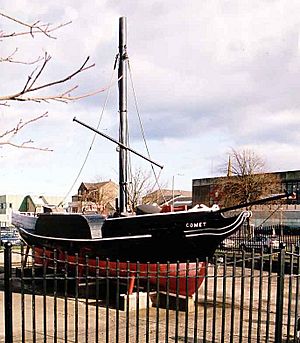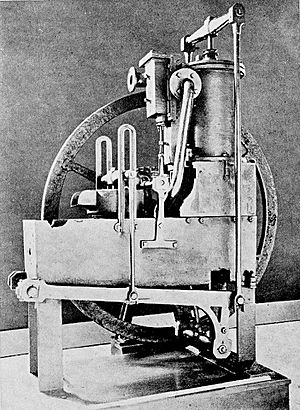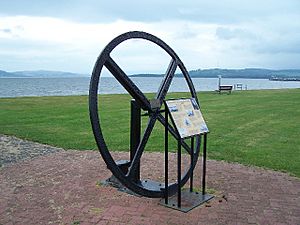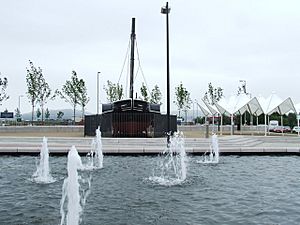PS Comet facts for kids

The replica of PS Comet in Port Glasgow town centre shows the elongated paddle boxes over the two paddle wheels on each side.
|
|
Quick facts for kids History |
|
|---|---|
| Name | PS Comet |
| Owner | Henry Bell |
| Launched | 24 July 1812 |
| Maiden voyage | August 1812 |
| Out of service | 21 December 1820 |
| Fate | Wrecked in strong currents at Craignish Point near Oban |
| General characteristics | |
| Tonnage | 28 ton |
| Length | 45 ft (14 m) |
| Beam | 10 ft (3.0 m) |
| Propulsion | Steam |
The PS Comet was a special kind of boat called a paddle steamer. It was built in 1812 for a man named Henry Bell. He owned a hotel and baths in Helensburgh, Scotland.
On August 15, 1812, the Comet started carrying passengers on the River Clyde between Glasgow and Greenock. This was the first time a steamboat service was truly successful for business in Europe!
Contents
The Story of the Comet
Henry Bell was very interested in boats that moved using steam power. He even wrote to Robert Fulton, who had built another steam-powered boat called the Charlotte Dundas. Bell wanted to learn from his experiences.
Building the First Comet
In the winter of 1811 and 1812, Henry Bell asked John and Charles Wood to build his new boat. They were shipbuilders in Port Glasgow. The boat was named Comet after a very bright comet seen in 1811.
The Comet was a small boat, about 43.5 feet (13.3 m) long and 11.25 feet (3.43 m) wide. It had two paddle wheels on each side. These wheels were powered by a small steam engine. The engine was built by John Robertson of Glasgow. The boiler, which made the steam, was made by David Napier.
The boat had a tall, thin funnel that also worked as a mast. This meant it could use a square sail if the wind was blowing in the right direction. There was a small cabin at the back with wooden seats. People said the Comet was "brightly painted" and had a figurehead of a lady dressed in many colors.
First Journeys and Service
The Comet was launched on July 24, 1812. Its first test trip was on August 6, from Port Glasgow to Glasgow. This 20 miles (32 kilometres) journey took three and a half hours.
At first, the double paddle wheels didn't work well. So, they were changed to a single paddle wheel on each side. This made the boat faster, reaching almost 7 knots!
On August 15, 1812, Henry Bell put an advertisement in a local newspaper. It said the Comet would start a regular passenger service. It would travel between Glasgow, Greenock, and Helensburgh. The trip was about 25 miles (40 kilometres) each way.
The Steamboat Comet Between Glasgow, Greenock and Helensburgh for Passengers Only
The subscriber, having at much expense, fitted up a handsome vessel to ply upon the River Clyde from Glasgow, to sail by the power of air, wind, and steam, intends that the vessel shall leave the Broomielaw on Tuesdays, Thursdays, and Saturdays about mid-day, or such hour thereafter as may answer from the state of the tide, and to leave Greenock on Mondays, Wednesdays, and Fridays in the morning to suit the tide.
This first commercial trip started the age of steamboats on the River Clyde. Soon, steamboats became popular all over Britain and Europe. A ticket for the "best cabin" cost four shillings, and three shillings for the "second."
The Comet's success led to many other steamboats being built. Soon, the Comet was not the newest or fastest boat. Henry Bell even tried a service on a different river, the Firth of Forth.
Famous People on Board
Some well-known people traveled on the Comet:
- Sir Walter Scott, a famous writer.
- James Watt, a famous inventor, who visited his hometown of Greenock in 1816.
The End of the First Comet
Henry Bell made the Comet longer and gave it a new engine. From September 1819, it traveled to Oban and Fort William. This trip took four days.
On December 15, 1820, the Comet was caught in strong currents near Oban and was wrecked. Henry Bell was on board, but luckily, no one was hurt. One of the engines from the Comet is now in The Science Museum in London.
The Story of Comet II
Henry Bell built another steamboat, which he named Comet II. But on October 21, 1825, a sad accident happened. Comet II crashed into another steamboat called the Ayr near Gourock, Scotland.
The Ayr, we learn, had a light out upon her bow, but the Comet had none. As the night, however, was clear, it is obvious that a bad look out had been kept up, and most reprehensible neglect shown on both sides. At the moment the accident took place, those on the deck of the Comet were, it is said, engaged in dancing. The passengers who were below were in high spirits, amusing themselves telling and listening to diverting tales. The first stroke hit about the paddle of the Comet. The Captain and passengers immediately ran upon deck to see what was wrong; when – the next fatal stroke took place with such force, that the Comet filled, and in two minutes went down head foremost. The moment this look place, the Ayr, instead of lending any assistance, gave her paddles a back stroke, turned round, and went off to Greenock, leaving them to their fate.
– The Sydney Gazette and New South Wales Advertiser, 25 Mar 1826, p3
The Comet II sank very quickly. Many passengers, about 62 out of 80, lost their lives. After losing his second ship, Henry Bell stopped working on steam navigation.
A Replica of the Comet
Today, you can see a copy of the original Comet in Port Glasgow. It was built by young people learning to be shipyard workers.




